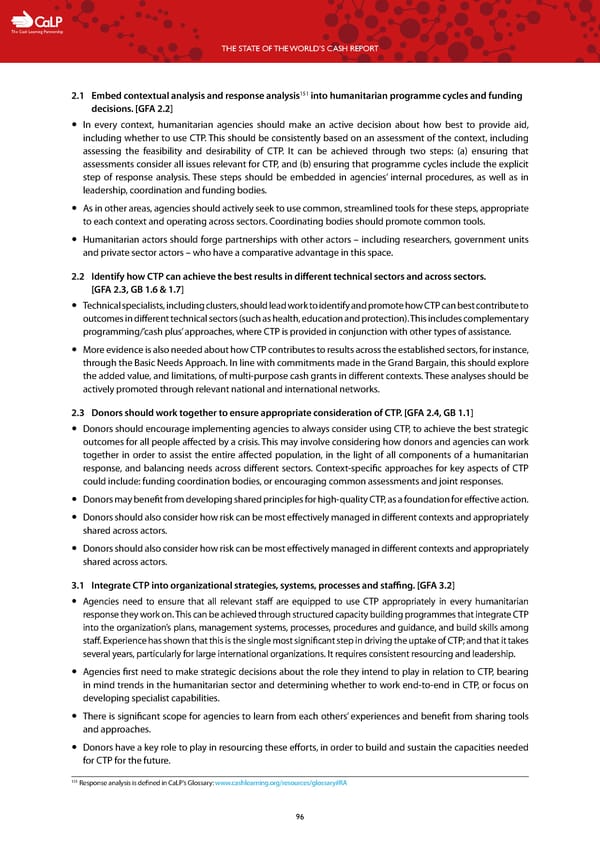C The Cash Learning Partnership THE STATE OF THE WORLD’S CASH REPORT 151 2.1 Embed c ontextual analysis and response analysis into humanitarian programme cycles and funding decisions. [GFA 2.2] — In every context, humanitarian agencies should make an active decision about how best to provide aid, including whether to use CTP. This should be consistently based on an assessment of the context, including assessing the feasibility and desirability of CTP. It can be achieved through two steps: (a) ensuring that assessments consider all issues relevant for CTP, and (b) ensuring that programme cycles include the explicit step of response analysis. These steps should be embedded in agencies’ internal procedures, as well as in leadership, coordination and funding bodies. — As in other areas, agencies should actively seek to use common, streamlined tools for these steps, appropriate to each context and operating across sectors. Coordinating bodies should promote common tools. — Humanitarian actors should forge partnerships with other actors – including researchers, government units and private sector actors – who have a comparative advantage in this space. 2.2 Iden tify how CTP can achieve the best results in different technical sectors and across sectors. [GFA 2.3, GB 1.6 & 1.7] — Technical specialists, including clusters, should lead work to identify and promote how CTP can best contribute to outcomes in different technical sectors (such as health, education and protection). This includes complementary programming/’cash plus’ approaches, where CTP is provided in conjunction with other types of assistance. — More evidence is also needed about how CTP contributes to results across the established sectors, for instance, through the Basic Needs Approach. In line with commitments made in the Grand Bargain, this should explore the added value, and limitations, of multi-purpose cash grants in different contexts. These analyses should be actively promoted through relevant national and international networks. 2.3 Donors should work together to ensure appropriate consideration of CTP. [GFA 2.4, GB 1.1] — Donors should encourage implementing agencies to always consider using CTP, to achieve the best strategic outcomes for all people affected by a crisis. This may involve considering how donors and agencies can work together in order to assist the entire affected population, in the light of all components of a humanitarian response, and balancing needs across different sectors. Context-specific approaches for key aspects of CTP could include: funding coordination bodies, or encouraging common assessments and joint responses. — Donors may benefit from developing shared principles for high-quality CTP, as a foundation for effective action. — Donors should also consider how risk can be most effectively managed in different contexts and appropriately shared across actors. — Donors should also consider how risk can be most effectively managed in different contexts and appropriately shared across actors. 3.1 Integrate CTP into organizational strategies, systems, processes and staffing. [GFA 3.2] — Agencies need to ensure that all relevant staff are equipped to use CTP appropriately in every humanitarian response they work on. This can be achieved through structured capacity building programmes that integrate CTP into the organization’s plans, management systems, processes, procedures and guidance, and build skills among staff. Experience has shown that this is the single most significant step in driving the uptake of CTP; and that it takes several years, particularly for large international organizations. It requires consistent resourcing and leadership. — Agencies first need to make strategic decisions about the role they intend to play in relation to CTP, bearing in mind trends in the humanitarian sector and determining whether to work end-to-end in CTP, or focus on developing specialist capabilities. — There is significant scope for agencies to learn from each others’ experiences and benefit from sharing tools and approaches. — Donors have a key role to play in resourcing these efforts, in order to build and sustain the capacities needed for CTP for the future. 151 Response analysis is defined in CaLP’s Glossary: www.cashlearning.org/resources/glossary#RA 96
 The State of the World's Cash | Full Report Page 97 Page 99
The State of the World's Cash | Full Report Page 97 Page 99